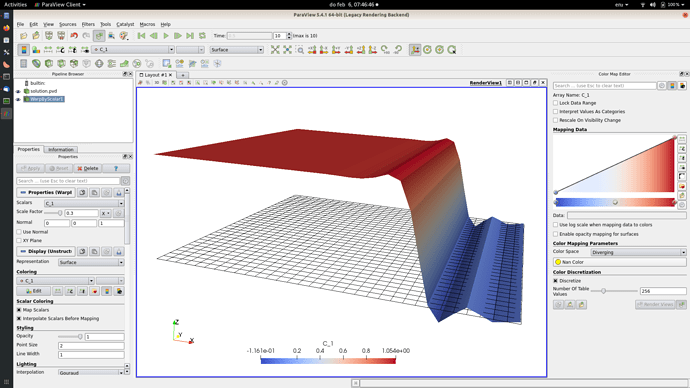Hi all,
I finally had the time to read up on SUPG (I have been using it with Q1 elements for 10 years but step 63 and other literature showed me that it was not so simple with Q2 elements :). If anybody is interested in a good textbook, I highly recommend the book by Donea & Huerta (see aspect manual bibliography)
Anyways, out of curiosity, I took one of the advection prm files in benchmark/advection/ and created a new one, which essentially models the advection of a heaviside function in 1D (see Fig 19 of Thieulot, PEPI 188, p47, 2011. https://doi.org/10.1016/j.pepi.2011.06.011 ). see attached pic also.
(the red and blue lines are SUPG, and gamma= \tau v/h )
There is 1 composition and the temperature field in the domain and both are initially set to the same value and subjected to the same boundary condition (T=1 at x=0, T=0 at x=1).
I also set the heat conductivity coefficient to zero, so that the Peclet number is infinite for temperature also. I then expect the same \delta_K parameter (see section 2.12.1 of aspect manual) for both composition and temperature. For a 32x32 mesh:
\delta_K = h / 2 d |\beta|_K = 1/ 32x2x2x1 (rho=cp=v=1 so \beta_K=1) = 0.0078125
I run the simulation for up to t=0.5, which allows the front to move from x=0.25 to x=0.75, and voluntarily set CFL = 0.1 so as to see many timesteps in paraview (but it is irrelevant).
When I look at the vtu file, the ‘artificial_viscosity’ field (which I interpret to be delta_K) is constant in space and in time and equal to 0.022. Since it is not equal to the value computed above, what am I not understanding? also, since for temperature often k=/=0 (i.e. Pe is finite) but Pe is always infinite for compositions why is there only one artificial_viscosity field?
I also attach the prm file.
Thanks!
Cedric/
front_supg.prm (3.0 KB)

